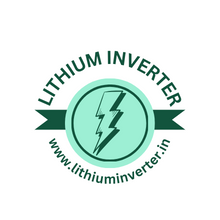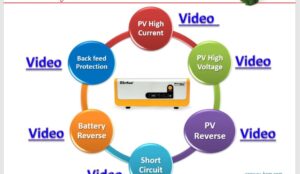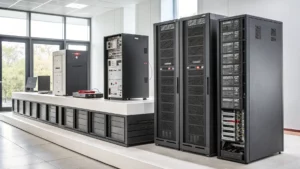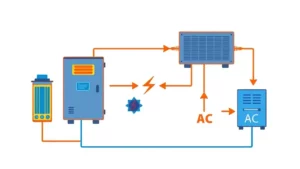Why Choose a Lithium Inverter? Discover the Advantages
Lithium inverters offer longer backup duration and faster recharge times due to their higher energy density and capacity. They can store more energy per unit of weight and size, making them more efficient. Lithium batteries have a slower discharge rate, allowing for longer recharge times. They are also environmentally friendly, as they do not contain lead or produce harmful emissions. However, they are more expensive than lead-acid inverters. While they offer environmental advantages like cleaner power output, longer lifespan, reduced maintenance, and potential for recycling, they also have environmental disadvantages.
[av_gallery ids=’3417,3441,3440,3416,3415,3414,3413,3412,3411,3410,3409,3408,3407,3406,3405,3403,3397′ style=’thumbnails’ preview_size=’portfolio’ crop_big_preview_thumbnail=’avia-gallery-big-crop-thumb’ thumb_size=’portfolio’ columns=’5′ imagelink=’lightbox’ link_dest=” lightbox_text=’caption’ lazyload=’avia_lazyload’ img_scrset=” html_lazy_loading=’disabled’ alb_description=” id=” custom_class=” template_class=” av_uid=’av-16ipj’ sc_version=’1.0′ admin_preview_bg=”]
Longer backup power: Lithium batteries have a higher energy density than lead-acid batteries so they can provide more backup power for a given size inverter.
Faster recharge times: Lithium batteries can be recharged much faster than lead-acid batteries. This means you can restore your backup power more quickly after a power outage.
1. Higher Capacity:
- Lithium-ion batteries boast a higher energy density than lead-acid batteries. This means they can store more energy per unit of weight and size. In simpler terms, a Suvastika lithium battery bank can pack more punch in a smaller, lighter package compared to a lead-acid battery bank with the same capacity. This translates to potentially doubling or even tripling your backup power duration for your appliances during outages.
2. Deeper Discharge:
- Lead-acid batteries typically shouldn’t be discharged below 50% regularly to maintain a healthy lifespan. Lithium-ion batteries, on the other hand, can often be discharged 80% or more without harming the battery. This means you can utilize a larger portion of the stored energy in your Suvastika lithium battery bank during a power outage, extending your backup power compared to lead-acid systems.
3. Slower Discharge Rate:
- Lithium-ion batteries naturally have a lower self-discharge rate compared to lead-acid batteries. This means a fully charged Suvastika lithium battery bank will hold its charge for longer periods when not in use. This is particularly advantageous if you experience infrequent power outages. You’ll have a fully charged battery bank ready when you need it most.
Environmentally friendly: Lithium batteries do not contain lead, which is a toxic metal. Additionally, lithium batteries do not produce harmful emissions when they are charged or discharged.
While lithium-ion batteries and inverters offer significant advantages over traditional options, there’s an asterisk when it comes to their eco-friendliness. Here’s a breakdown of the positive and negative aspects:
1. Environmental Advantages:
- Cleaner Power Output (Inverter): Compared to generators that burn fossil fuels, inverters with lithium-ion batteries produce clean electricity during power outages. This reduces air pollution and greenhouse gas emissions.
- Longer Lifespan (Lithium Battery): Lithium-ion batteries typically last 2-3 times longer than lead-acid batteries used in inverters. This reduces the need for frequent replacements and disposal of old batteries, lowering the overall environmental impact.
- Reduced Maintenance (Lithium Battery): Unlike lead-acid batteries, lithium-ion batteries require no regular maintenance like topping up electrolytes. This eliminates the need for disposal of hazardous materials like lead-acid battery acid.
- Potential for Recycling (Both): Both lithium-ion batteries and inverter components have recycling potential. Responsible manufacturers are working on improving recycling processes to recover valuable materials.
2. Environmental Disadvantages:
- Raw Material Extraction: Mining raw materials like lithium, cobalt, and nickel for lithium-ion batteries can have environmental consequences, including habitat destruction and water pollution.
- Battery Manufacturing: The manufacturing process for lithium-ion batteries can be energy-intensive and may involve the use of harmful chemicals.
- End-of-Life Disposal: Improper disposal of lithium-ion batteries can pose environmental hazards due to the presence of toxic materials. However, recycling is becoming increasingly available.
3. Overall:
While not entirely “green,” lithium-ion batteries and inverters can be a more environmentally friendly option compared to traditional technologies when you consider the following:
- Reduced reliance on fossil fuels: By enabling the use of renewable energy sources like solar panels with battery backup, these systems can significantly lower greenhouse gas emissions in the long run.
- Improved life cycle: The longer lifespan and lower maintenance requirements of lithium-ion batteries translate to less waste generation compared to lead-acid batteries.
- Advancements in Recycling: Recycling technologies are constantly improving, offering a more sustainable solution for end-of-life batteries and inverters.
Here are some of the disadvantages of using a lithium inverter:
Price comparison: Lithium inverters are typically more expensive than lead-acid inverters if a small load is to run; otherwise, a Lithium battery is cheaper than a lead-acid battery.
Here’s a comparison of Lithium and Lead-acid batteries for inverters in India, considering price and life cycle:
Price:
- upfront cost:
- Lead-acid batteries are generally cheaper upfront. In India, a typical 150Ah lead-acid battery for an inverter might cost around ₹7,000 – ₹12,000.
- Lithium-ion batteries cost significantly more upfront. A comparable 100Ah Lithium battery for an inverter in India could range from ₹8,000 – ₹15,000.
- Long-term cost: While the upfront cost is higher, lithium-ion batteries can be more economical in the long run due to several factors:
- Lifespan: Lithium-ion batteries typically last 2-3 times longer than lead-acid batteries (around 7-10 years vs 2-5 years). This means you’ll need to replace lead-acid batteries more frequently, increasing overall costs.
- Maintenance: Lead-acid batteries require periodic maintenance like topping up electrolytes with distilled water. Lithium-ion batteries are maintenance-free.
Life Cycle:
-
Lead-acid Batteries:
- Lower upfront cost
- Shorter lifespan (2-5 years)
- Require regular maintenance (topping up electrolytes)
- Lower depth of discharge (around 50% recommended for a healthy lifespan)
- Environmentally less friendly due to disposal concerns and lead content
-
- Higher upfront cost
- Longer lifespan (7-10 years)
- Maintenance-free
- Deeper discharge cycles (around 80% usable capacity)
- More environmentally friendly due to longer lifespan and potentially better recycling options
Additional factors to consider in India:
- Availability: Lead-acid batteries are more widely available throughout India. Lithium-ion battery availability might be better in metro and Tier-1 cities.
- System Compatibility: Ensure the chosen battery is compatible with your inverter model.
- Warranty: Compare warranty periods offered by manufacturers for both battery types.
Here are some resources to help you compare specific battery prices in India:
- Online marketplaces like Amazon or Flipkart can provide real-time price comparisons for various battery models.
- Inverter and battery manufacturers’ websites often list the prices of their products.
Nowadays, manufacturers like Su-vastika offer Lithium and Lead Acid Inverter charging options in their Inverter/UPS, advanced technology with Bluetooth, and Wifi-based Inverter/UPS.
Overall, lithium inverters offer several advantages over lead-acid inverters. If you are looking for an inverter with the most prolonged backup power and fastest recharge times, a lithium inverter is a good option.
Many companies are trying to build Inverters with built-in Lithium based battery which has a challenge of BMS.
As BMS is always on so, the self-discharge of the battery increases, which prevents the seller from keeping the inverter with a built-in lithium battery for a longer duration.
The future is Lithium Inverter for the coming times as no one wants pollution in their homes or offices by installing Lead Acid batteries.




